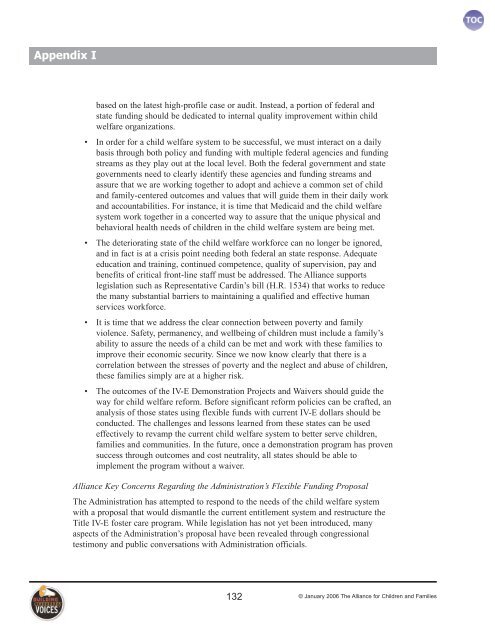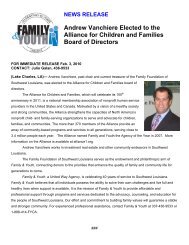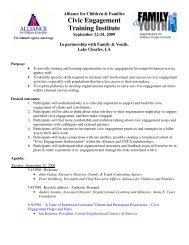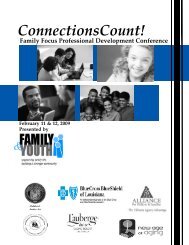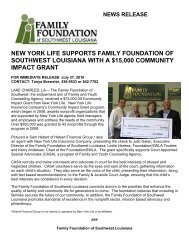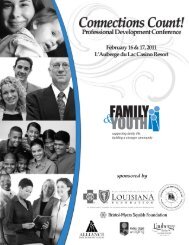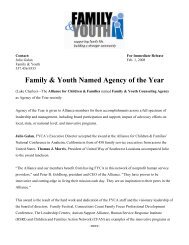Mission-based Advocacy Toolkit from Alliance for Children & Families
Mission-based Advocacy Toolkit from Alliance for Children & Families
Mission-based Advocacy Toolkit from Alliance for Children & Families
Create successful ePaper yourself
Turn your PDF publications into a flip-book with our unique Google optimized e-Paper software.
Appendix I<br />
<strong>based</strong> on the latest high-profile case or audit. Instead, a portion of federal and<br />
state funding should be dedicated to internal quality improvement within child<br />
welfare organizations.<br />
• In order <strong>for</strong> a child welfare system to be successful, we must interact on a daily<br />
basis through both policy and funding with multiple federal agencies and funding<br />
streams as they play out at the local level. Both the federal government and state<br />
governments need to clearly identify these agencies and funding streams and<br />
assure that we are working together to adopt and achieve a common set of child<br />
and family-centered outcomes and values that will guide them in their daily work<br />
and accountabilities. For instance, it is time that Medicaid and the child welfare<br />
system work together in a concerted way to assure that the unique physical and<br />
behavioral health needs of children in the child welfare system are being met.<br />
• The deteriorating state of the child welfare work<strong>for</strong>ce can no longer be ignored,<br />
and in fact is at a crisis point needing both federal an state response. Adequate<br />
education and training, continued competence, quality of supervision, pay and<br />
benefits of critical front-line staff must be addressed. The <strong>Alliance</strong> supports<br />
legislation such as Representative Cardin’s bill (H.R. 1534) that works to reduce<br />
the many substantial barriers to maintaining a qualified and effective human<br />
services work<strong>for</strong>ce.<br />
• It is time that we address the clear connection between poverty and family<br />
violence. Safety, permanency, and wellbeing of children must include a family’s<br />
ability to assure the needs of a child can be met and work with these families to<br />
improve their economic security. Since we now know clearly that there is a<br />
correlation between the stresses of poverty and the neglect and abuse of children,<br />
these families simply are at a higher risk.<br />
• The outcomes of the IV-E Demonstration Projects and Waivers should guide the<br />
way <strong>for</strong> child welfare re<strong>for</strong>m. Be<strong>for</strong>e significant re<strong>for</strong>m policies can be crafted, an<br />
analysis of those states using flexible funds with current IV-E dollars should be<br />
conducted. The challenges and lessons learned <strong>from</strong> these states can be used<br />
effectively to revamp the current child welfare system to better serve children,<br />
families and communities. In the future, once a demonstration program has proven<br />
success through outcomes and cost neutrality, all states should be able to<br />
implement the program without a waiver.<br />
<strong>Alliance</strong> Key Concerns Regarding the Administration’s Flexible Funding Proposal<br />
The Administration has attempted to respond to the needs of the child welfare system<br />
with a proposal that would dismantle the current entitlement system and restructure the<br />
Title IV-E foster care program. While legislation has not yet been introduced, many<br />
aspects of the Administration’s proposal have been revealed through congressional<br />
testimony and public conversations with Administration officials.<br />
132<br />
© January 2006 The <strong>Alliance</strong> <strong>for</strong> <strong>Children</strong> and <strong>Families</strong>


